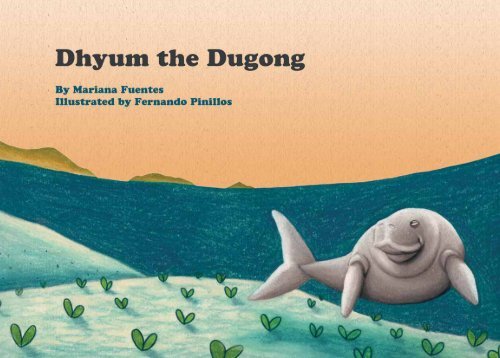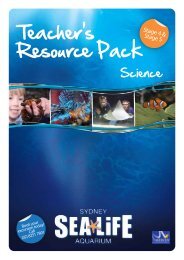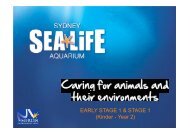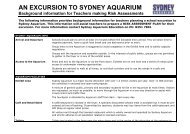Dhyum the Dugong - ARC Centre of Excellence for Coral Reef Studies
Dhyum the Dugong - ARC Centre of Excellence for Coral Reef Studies
Dhyum the Dugong - ARC Centre of Excellence for Coral Reef Studies
You also want an ePaper? Increase the reach of your titles
YUMPU automatically turns print PDFs into web optimized ePapers that Google loves.
© Copyright Mariana Fuentes, 2012The Copyright Act 1968 permits fair dealing <strong>for</strong> study,research, in<strong>for</strong>mation or educational purposes subject to<strong>the</strong> inclusion <strong>of</strong> a sufficient acknowledgement <strong>of</strong> <strong>the</strong>source.Fuentes, M. (2012) <strong>Dhyum</strong> <strong>the</strong> <strong>Dugong</strong>. <strong>Reef</strong> & Rain<strong>for</strong>estResearch <strong>Centre</strong> Limited, Cairns, Australia (32pp.).ISBN 978-1-921359-86-6 (pbk.)ISBN 978-1-921359-88-0 (.pdf)Published by <strong>the</strong> <strong>Reef</strong> & Rain<strong>for</strong>est Research <strong>Centre</strong> Ltd.PO Box 1762, Cairns QLD 4870, Australiahttp://www.rrrc.org.au/The <strong>Reef</strong> & Rain<strong>for</strong>est Research <strong>Centre</strong> (RRRC) is a not<strong>for</strong>-pr<strong>of</strong>itorganisation working across Nor<strong>the</strong>rn Australia,<strong>the</strong> Torres Strait, Papua New Guinea and <strong>the</strong> Pacific. TheRRRC partners with governments, research institutions,donor agencies and NGOs to deliver environmentalsolutions <strong>for</strong> <strong>the</strong> tropics.Illustrations by Fernando Pinillos,http://www.drawingscience.com/Design and layout by Shannon Hogan,http://www.adelphapublishing.com/Printed and bound in North Queensland byLotsa Print and Design, http://www.lotsa.com.auAlso by Mariana Fuentes:Myrtle’s battle against climate changeISBN 978-1-921359-42-2 (pbk.)ISBN 978-1-921359-43-9 (PDF)http://www.marianafuentes.com/IntroductionThe main character <strong>of</strong> <strong>the</strong> book, ‘<strong>Dhyum</strong>’ is based on a real dugong that was satellite-taggedin 2010 at Mabuiag Island in Torres Strait. <strong>Dhyum</strong> was named by students from <strong>the</strong> localTagai State College.This book is dedicated to <strong>the</strong> children <strong>of</strong> <strong>the</strong> Torres Strait islands with <strong>the</strong> hope that <strong>the</strong>ylearn more about dugongs and <strong>the</strong> threats faced by <strong>the</strong> species, so <strong>the</strong>y understand <strong>the</strong>importance <strong>of</strong> working to preserving <strong>the</strong>m.About <strong>the</strong> AuthorOriginally from Brazil, Mariana Fuentes moved to Australia a decade ago to become a marinebiologist. She has been working on marine megafauna conservation and managementprograms <strong>for</strong> <strong>the</strong> last ten years.Mariana’s commitment to building <strong>the</strong> capacity <strong>of</strong> local communities to preserve marinemegafauna, such as dugongs, led to <strong>the</strong> development <strong>of</strong> this book, which aims to educateTorres Strait children about <strong>the</strong> perils faced by dugongs and what <strong>the</strong>se challenges mean to<strong>the</strong> Torres Strait communities.AcknowledgementsFunding to support book design and print production was provided by <strong>the</strong> Save Our SeasFoundation, <strong>the</strong> Torres Strait Regional Authority and <strong>the</strong> Australian Research Council (<strong>ARC</strong>)<strong>Centre</strong> <strong>of</strong> <strong>Excellence</strong> <strong>for</strong> <strong>Coral</strong> <strong>Reef</strong> <strong>Studies</strong>. The author is grateful <strong>for</strong> <strong>the</strong> editorial andtechnical help and support provided by Shannon Hogan, and <strong>for</strong> comments and suggestionsfrom <strong>the</strong> Tropical and Marine Wildlife Group at James Cook University, especially Pr<strong>of</strong>essorHelene Marsh. The author is particularly grateful <strong>for</strong> <strong>the</strong> comments provided by Nisha RoseHamann.Mariana Fuentes’ research is supported by <strong>the</strong> <strong>ARC</strong> <strong>Centre</strong> <strong>of</strong> <strong>Excellence</strong> <strong>for</strong> <strong>Coral</strong> <strong>Reef</strong><strong>Studies</strong>, <strong>the</strong> Save Our Seas Foundation and <strong>the</strong> Australian Research Council.For more in<strong>for</strong>mation about community based dugong conservation and managementinitiatives, contact <strong>the</strong> Torres Strait Regional Authority (http://www.tsra.gov.au/).
Hi, I’m <strong>Dhyum</strong>!I’m a dugong.Today I will tell you a little bitabout myself and my family.
<strong>Dugong</strong>s are largemammals that livein <strong>the</strong> sea.
Mammals are animals that have hair, lungs tobrea<strong>the</strong> air and produce milk <strong>for</strong> <strong>the</strong>ir babies.Humans are mammals too.<strong>Dugong</strong>s can growup to three metres inlength, and weigh up to500 kilograms.
<strong>Dugong</strong>s can live<strong>for</strong> up to 70 years.Female dugongs have <strong>the</strong>ir first baby when<strong>the</strong>y are between 6 and 17 years <strong>of</strong> age.They will <strong>the</strong>n have babies every 2-5 years.
<strong>Dugong</strong>s have one babyafter 13-15 months <strong>of</strong>pregnancy.A young dugong will stayclose to its mo<strong>the</strong>r <strong>for</strong> about18 months after it is born.
<strong>Dugong</strong>s eat seagrass.Animals that eat only plants, likedugongs, are herbivores, and thosethat eat only meat, like crocodiles,are carnivores.Humans are omnivores. They eatplants as well as vegetables and meat.
An adult dugonglike me will eat up to30 kilograms <strong>of</strong> seagrasseach day!Seagrasses are flowering plants found in shallow areas.
We are usuallyfound in shallow waterswhere <strong>the</strong>re is lots<strong>of</strong> seagrass.
But we canalso be found indeeper waters.
<strong>Dugong</strong>s can be found in at least 37countries, from Madagascar to Vanuatu.
I live in seagrass beds inTorres Strait, which is a veryimportant place <strong>for</strong> dugongs.It has <strong>the</strong> largest numbers<strong>of</strong> dugongs in <strong>the</strong> world.
Human activities are causing dugongsto disappear from some places.The threats that dugongs face varyat each location.
It’s very difficult <strong>for</strong> dugongs to escapefrom fast moving boats. In areas with lots<strong>of</strong> boats, dugongs can be hit, particularlyif <strong>the</strong> water is shallow.
<strong>Dugong</strong>s can only hold <strong>the</strong>ir breath <strong>for</strong> a short time.If <strong>the</strong>y become trapped in fishing nets <strong>the</strong>y can drown.
We can also beaffected when seagrasses,our food source, are impacted.Seagrass beds can diewhen water is too polluted.
The health <strong>of</strong> seagrass beds can also beaffected by shipping ports, seabed dredging,cyclones and floods.
<strong>Dugong</strong>s living in areas that have many environmental threats are most at risk.
It is hard <strong>for</strong> us to recover fromthreats because we take a long timeto grow and have babies.
A reduction in dugong numbers can be a problemto Indigenous communities because dugongs arepart <strong>of</strong> Island culture.It can also be a problem <strong>for</strong> <strong>the</strong> environment,because dugongs have important roles in marineecosystems.Where are <strong>the</strong> dugongs?They used to be here!What are we going to do now?
When boating in shallow waters be on <strong>the</strong>lookout <strong>for</strong> dugongs to avoid hitting <strong>the</strong>m.Several thingscan be done toreduce threatsto dugongs.
Keep seagrass beds healthyby keeping <strong>the</strong> ocean clean.
Learn about dugongs so you can help to look after <strong>the</strong>m.Find out where <strong>the</strong>y live, how <strong>the</strong>y move between places, howbig <strong>the</strong>ir families are and how <strong>the</strong>ir numbers change over time.
By surveying dugong populations byplane, scientists can collect in<strong>for</strong>mationon dugong distribution and see wheremost dugongs are.From <strong>the</strong> air we can seedugongs better.
Scientists also use satellite tags attached to our tails so<strong>the</strong>y can monitor where we go and how we move.The tags send signalsto satellites in space.
Scientists download this in<strong>for</strong>mationfrom satellites to <strong>the</strong>ir computers.I was satellite tagged in 2010.Now rangers and scientists know that I move all<strong>the</strong> way to Papua New Guinea from Torres Strait.
The in<strong>for</strong>mation being collected by rangers and scientists is being used indugong management plans. Torres Strait traditional people have created<strong>the</strong> plans to work out how each community will use dugongs.
This will help preserve dugongpopulations so that <strong>the</strong>y’ll still be here<strong>for</strong> many future generations!








